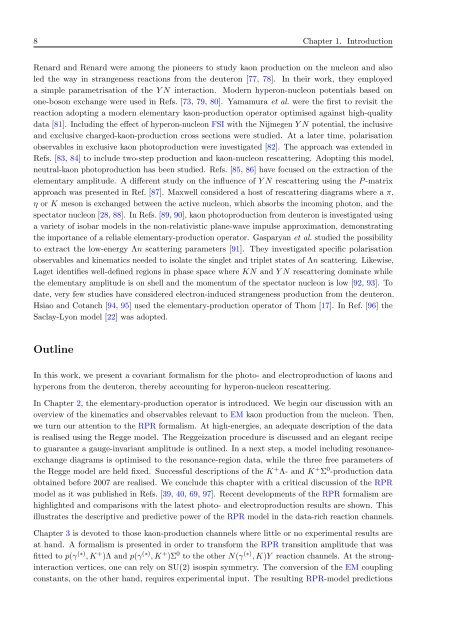Download Thesis in Pdf Format - Theoretical Nuclear Physics and ...
Download Thesis in Pdf Format - Theoretical Nuclear Physics and ...
Download Thesis in Pdf Format - Theoretical Nuclear Physics and ...
Create successful ePaper yourself
Turn your PDF publications into a flip-book with our unique Google optimized e-Paper software.
8 Chapter 1. IntroductionRenard <strong>and</strong> Renard were among the pioneers to study kaon production on the nucleon <strong>and</strong> alsoled the way <strong>in</strong> strangeness reactions from the deuteron [77, 78]. In their work, they employeda simple parametrisation of the Y N <strong>in</strong>teraction. Modern hyperon-nucleon potentials based onone-boson exchange were used <strong>in</strong> Refs. [73, 79, 80]. Yamamura et al. were the first to revisit thereaction adopt<strong>in</strong>g a modern elementary kaon-production operator optimised aga<strong>in</strong>st high-qualitydata [81]. Includ<strong>in</strong>g the effect of hyperon-nucleon FSI with the Nijmegen Y N potential, the <strong>in</strong>clusive<strong>and</strong> exclusive charged-kaon-production cross sections were studied. At a later time, polarisationobservables <strong>in</strong> exclusive kaon photoproduction were <strong>in</strong>vestigated [82]. The approach was extended <strong>in</strong>Refs. [83, 84] to <strong>in</strong>clude two-step production <strong>and</strong> kaon-nucleon rescatter<strong>in</strong>g. Adopt<strong>in</strong>g this model,neutral-kaon photoproduction has been studied. Refs. [85, 86] have focused on the extraction of theelementary amplitude. A different study on the <strong>in</strong>fluence of Y N rescatter<strong>in</strong>g us<strong>in</strong>g the P -matrixapproach was presented <strong>in</strong> Ref. [87]. Maxwell considered a host of rescatter<strong>in</strong>g diagrams where a π,η or K meson is exchanged between the active nucleon, which absorbs the <strong>in</strong>com<strong>in</strong>g photon, <strong>and</strong> thespectator nucleon [28, 88]. In Refs. [89, 90], kaon photoproduction from deuteron is <strong>in</strong>vestigated us<strong>in</strong>ga variety of isobar models <strong>in</strong> the non-relativistic plane-wave impulse approximation, demonstrat<strong>in</strong>gthe importance of a reliable elementary-production operator. Gasparyan et al. studied the possibilityto extract the low-energy Λn scatter<strong>in</strong>g parameters [91]. They <strong>in</strong>vestigated specific polarisationobservables <strong>and</strong> k<strong>in</strong>ematics needed to isolate the s<strong>in</strong>glet <strong>and</strong> triplet states of Λn scatter<strong>in</strong>g. Likewise,Laget identifies well-def<strong>in</strong>ed regions <strong>in</strong> phase space where KN <strong>and</strong> Y N rescatter<strong>in</strong>g dom<strong>in</strong>ate whilethe elementary amplitude is on shell <strong>and</strong> the momentum of the spectator nucleon is low [92, 93]. Todate, very few studies have considered electron-<strong>in</strong>duced strangeness production from the deuteron.Hsiao <strong>and</strong> Cotanch [94, 95] used the elementary-production operator of Thom [17]. In Ref. [96] theSaclay-Lyon model [22] was adopted.Outl<strong>in</strong>eIn this work, we present a covariant formalism for the photo- <strong>and</strong> electroproduction of kaons <strong>and</strong>hyperons from the deuteron, thereby account<strong>in</strong>g for hyperon-nucleon rescatter<strong>in</strong>g.In Chapter 2, the elementary-production operator is <strong>in</strong>troduced. We beg<strong>in</strong> our discussion with anoverview of the k<strong>in</strong>ematics <strong>and</strong> observables relevant to EM kaon production from the nucleon. Then,we turn our attention to the RPR formalism. At high-energies, an adequate description of the datais realised us<strong>in</strong>g the Regge model. The Reggeization procedure is discussed <strong>and</strong> an elegant recipeto guarantee a gauge-<strong>in</strong>variant amplitude is outl<strong>in</strong>ed. In a next step, a model <strong>in</strong>clud<strong>in</strong>g resonanceexchangediagrams is optimised to the resonance-region data, while the three free parameters ofthe Regge model are held fixed. Successful descriptions of the K + Λ- <strong>and</strong> K + Σ 0 -production dataobta<strong>in</strong>ed before 2007 are realised. We conclude this chapter with a critical discussion of the RPRmodel as it was published <strong>in</strong> Refs. [39, 40, 69, 97]. Recent developments of the RPR formalism arehighlighted <strong>and</strong> comparisons with the latest photo- <strong>and</strong> electroproduction results are shown. Thisillustrates the descriptive <strong>and</strong> predictive power of the RPR model <strong>in</strong> the data-rich reaction channels.Chapter 3 is devoted to those kaon-production channels where little or no experimental results areat h<strong>and</strong>. A formalism is presented <strong>in</strong> order to transform the RPR transition amplitude that wasfitted to p(γ (∗) , K + )Λ <strong>and</strong> p(γ (∗) , K + )Σ 0 to the other N(γ (∗) , K)Y reaction channels. At the strong<strong>in</strong>teractionvertices, one can rely on SU(2) isosp<strong>in</strong> symmetry. The conversion of the EM coupl<strong>in</strong>gconstants, on the other h<strong>and</strong>, requires experimental <strong>in</strong>put. The result<strong>in</strong>g RPR-model predictions















